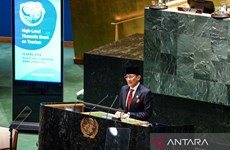Singapore faces water shortage
Singaporeans have to start curbing their water usage as the island state’s water supply has reached a historic low.
Singaporeans have to start curbing their water usage as the island state’s water supply has reached a historic low.
Minister of Environment and Water Resources Vivian Balakrishnan said on August 3 that if the situation becomes worse, Singapore may have to apply water use restrictions, such as banning the use of water to clean public areas.
However, such restrictions have not been applied because the country still keeps its own reservoirs full by ramping up supply from its seawater and increasing the capacity of water treatment plants, he added.
Currently, Singapore draws up to 250 million gallons of water (about 1.14 million cubic meters) a day, or about 60 percent of its water needs, from the Johor River in Malaysia.
But this is only possible when the Linggiu Reservoir in Johor releases water into the river, preventing seawater from intruding into the river.
Since 2014, water levels in the reservoir have been steadily falling and have now reached a historic low of 54.5 percent of its capacity.
An El Nino phenomenon is expected to lead the even drier weather than usual for the rest of the year, which will further affect water supplies from the river as well as Singapore’s own reservoirs.
In order to deal with this situation, the country has planned several infrastructural projects in the next few years, including the building of a dam on Johor River, a waste water treatment plant and a seawater desalinization factory.
Once they become operational, Singapore will be able to meet up to about 70 percent of its water needs.
Singapore’s agreement to obtain water from Malaysia will be terminated in 2061 and by then the country is expected to meet up 80 percent of its water needs through seawater desalinization and sewage treatment.-VNA
Minister of Environment and Water Resources Vivian Balakrishnan said on August 3 that if the situation becomes worse, Singapore may have to apply water use restrictions, such as banning the use of water to clean public areas.
However, such restrictions have not been applied because the country still keeps its own reservoirs full by ramping up supply from its seawater and increasing the capacity of water treatment plants, he added.
Currently, Singapore draws up to 250 million gallons of water (about 1.14 million cubic meters) a day, or about 60 percent of its water needs, from the Johor River in Malaysia.
But this is only possible when the Linggiu Reservoir in Johor releases water into the river, preventing seawater from intruding into the river.
Since 2014, water levels in the reservoir have been steadily falling and have now reached a historic low of 54.5 percent of its capacity.
An El Nino phenomenon is expected to lead the even drier weather than usual for the rest of the year, which will further affect water supplies from the river as well as Singapore’s own reservoirs.
In order to deal with this situation, the country has planned several infrastructural projects in the next few years, including the building of a dam on Johor River, a waste water treatment plant and a seawater desalinization factory.
Once they become operational, Singapore will be able to meet up to about 70 percent of its water needs.
Singapore’s agreement to obtain water from Malaysia will be terminated in 2061 and by then the country is expected to meet up 80 percent of its water needs through seawater desalinization and sewage treatment.-VNA












